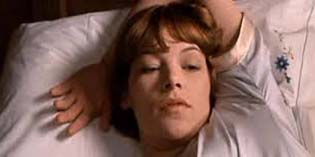I can’t ever really say that I was a fan of the work of Ken Russell. I’m all for meeting a film artist halfway in interpreting his work, but Russell always seemed to be asking me to do more heavy lifting then I was willing to supply. He was an experimenter, employing camera tricks and symbolic representation at the expense of giving us a cohesive story. I was always left baffled and sometimes downright confused. I suspect that I’m not alone.
Russell seemed to have an obsession with two things: sex and the Catholic Church. What one had to do with the other is kind of obvious; he employed his flamboyant visual style to tie in the evils of lust with the sexual restraints imposed by the church. Yet, I always knew watching his work that somewhere down the way, he was going to leave the plane of functional narrative and start doing an interpretive dance with his camera, a pas de deux of artistic treacle that meant nothing to anyone but himself.
The only film of his that I have ever really returned to was one of his most famous, a 1969 adaptation of D.H. Lawrence’s Women in Love, noted today for its nude wrestling match between male stars Alan Bates and Oliver Reed, but also for a wonderful performance by Glenda Jackson, a 31 year-old actress that hardly anyone in the states had ever heard of, but would none-the-less come out of nowhere to win the year’s Oscar for Best Actress.
The movie is no less than an examination of two relationships as Jackson plays the unfortunately named Gudrun Brangwen, a sexually free young woman in post-WWI England, who begins a relationship with a stuffy English officer named Gerald played by Oliver Reed. Meanwhile her sister Ursula (the wonderful Jennie Linden) begins a sexual liaison with free-wheeling chap named Rupert (Alan Bates). The movie mixes up all the problems that these two couples could possibly have, sexually and otherwise while dealing not-so-understatedly with the notion that the uptight Gerald is courting Gudrun while really holding on to buried affections for Rupert.
Where the movie steps right is when it deals with the characters, most interestingly between Gerald and Gudrud. Gerald loves Gudrud’s fiery passion but she admits that he really doesn’t know how to love her. He is full of anger and frustration and doesn’t really understand her. Gudrud is a woman with personality and intelligence whose sexuality is surprisingly frank, but she is also sexually liberated in the head. Not content to just be taken, she wants to be made love to mentally as well as physically. She’s very smart, her mind is open where Gerald’s fits love and sex into a box of rules and order. She penetrates right to his inner weakness and it is a trait he cannot deal with. He can’t give her the proper kind of passion that she desires.
When the movie stays in that relationship it is fine, but as I said, Russell can’t resist moving into murky artistic dalliances that push me away from the film. There’s a subplot involving a sexually active young couple who turn up dead in a ditch for no reason that I could ever really figure out; and that’s juxtaposed with Ursula and Rupert having sex as the camera turns sideways, what?!?
Women in Love is more or less forgotten today. It isn’t a bad film but were it not for the performances, especially by Glenda Jackson, it would have completely faded into obscurity. It’s worth a look, but take it at face value. Russell is definitely an acquired taste.
